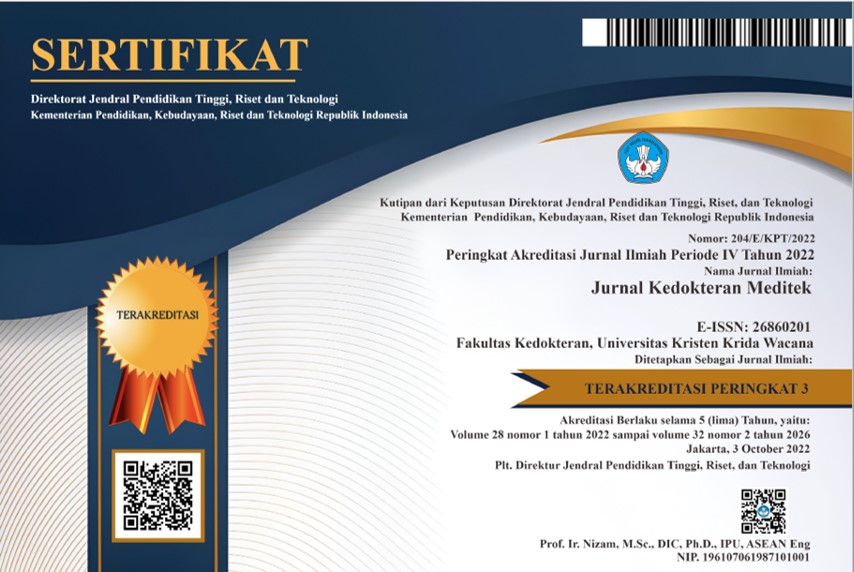Heterogenitas pada Struktur Genotipe Hepatitis C Virus
DOI:
https://doi.org/10.36452/jkdoktmeditek.v22i59.1273Abstract
Abstrak
Hepatitis C merupakan penyakit yang disebabkan oleh virus hepatitis C (HCV), famili Flaviviridae, genom Ribo Nuclead Acid (RNA), berutas tunggal, polaritas positif. Hidup dan bereplikasi di dalam sel hapatosit. Stuktur genom HCV terdiri atas satu ORF (open reading frame) yang memberi kode pada polipeptida komponen struktural, terdiri atas nukleokapsid (inti C), protein selubung atau envelope (E1 dan E2), serta bagian non struktural dibagi menjadi NS2, NS3, NS4a, NS4b, NS5a, dan NS5b. Bagian genom HCV yang paling stabil adalah nukleokapsid atau protein inti (core), dan dipakai untuk deteksi antibodi dalam serum pasien. Protein envelope E2 merupakan bagian HCV yang sangat heterogen, dan yang paling tinggi variabilitasnya sehingga disebut hypervariabel region 1 (HVR 1). Berdasarkan struktur genom HCV yang heterogen tersebut penggolongn HVC berdasarkan genotip, subtipe dan kuasispesies. Penelitian sekuens genom HCV membuktikan bahwa keragaman kuasipsesies pada HCV memunyai korelasi yang kuat dengan kemampuan progresivitas dan kronisitas virus terhadap hospes. Selama proses replikasi virus, menutup fungsi normal hepatosit atau membuat lebih banyak lagi hepatosit yang terinfeksi. Tingkat penularan yang tinggi terjadi pada pasien dengan riwayat sebagai pengguna narkoba jarum suntik (53%), dan janin akan tertular dari ibu pengidap HCV (25%).
Kata Kunci: HCV, Flaviridae, Hepatosit, Quasispesies, Hypervariabel Region 1.
Â
Abstract
              Hepatitis C is a disease caused by the hepatitis C virus (HCV), family Flaviviridae, genome Ribo Nuclead Acid (RNA), single-strand, positive polarity. Live and replicate inside hepatocyte cells. Structure of the genome of HCV consists of ORF (open reading frame) that encodes the polypeptide structural components, consisting of nucleocapsid (core C), protein sheath or envelope (E1 and E2), as well as parts of non structurally divided into NS2, NS3, NS4a, NS4b, NS5a and NS5B. HCV genome is part of the most stable nucleocapsid or core protein and used for the detection of antibodies in the serum of patients. E2 envelope protein of HCV is part of a very heterogeneous, and the most high variability so-called hypervariabel region 1 (HVR 1). Based on the structure of the heterogeneous HCV genome. HVC classified by genotype, subtype and quasispecies. Research proved that the HCV genome sequences in the HCV quasipsecies diversity has a strong correlation with the progression and chronicity of the virus to the host. During the process of viral replication closes normal hepatocyte function or make more of an infected hepatocytes. The transmission rate is higher in patients with  history of injecting drug users (53%) and fetus can be infected  from mothers with HCV (25%).
Â
Keywords: HCV, Flaviviridae, Hepatocytes, Quasispecies, Hypervariable Region 1.
















